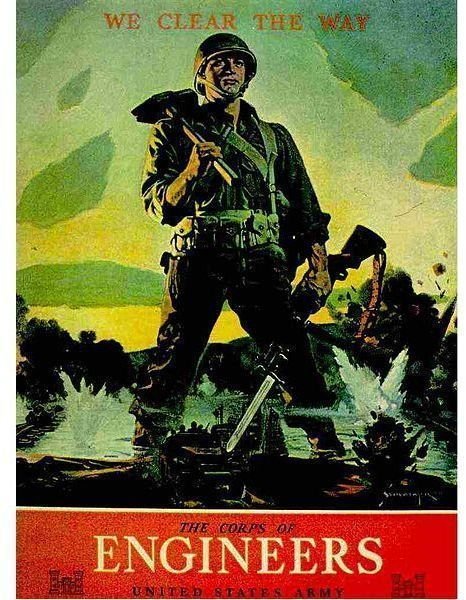US Army Corp of Engineers - History and Major Works
Currently the U.S. Army Corp of Engineers is mainly known for its construction and maintenance of civil engineering structures such as levees, damns, jetties, and contributions to parks and monuments. But did you know that their contributions go back to when the United States was in its infancy?
Battlefield Sappers
To quote George Patton: “Wars may be fought with weapons, but they are won by men!”
During a war, combat engineers that join the troops in the front line during battle are also known as sappers. The term “sapper” goes as far as back as 1501 during the Siege of Rouen, which had occurred during the French wars. After the wars were over, reformation of the land was also the responsibility of the battlefield engineers.
In World War II, this remarkable profession allowed American soldiers to overtake Omaha Beach on D-Day by providing ordinance called the “M1A1 Bangalore,” a specialized ground tube torpedo that would blast away obstructions like barbed wire and low embankments to clear a path to allow our troops to make their way into German territory.
Several varieties of combat engineers were involved in the battles. For instance, mechanized combat engineers fell into formation around armored personnel carriers and were equipped with a variety of heavy and light rifles as well as demolition ordinance and anti-tank weapons. When moving forward into the battlefield, they could unleash a tremendous amount of fire power as they established what was basically a portable minefield around their position.
Another combat sapper classification was the wheeled combat engineers. They were basically arranged and equipped like the combat engineers. The main difference was their method of transport; it was a five-ton dump truck.
The light engineers moved on foot. They would carry the same tools and equipment as any combat soldier as well as their demolition materials. As part of a platoon, they would move in the same fashion as light infantry with the same firing and maneuvering techniques as well as close combat fighting.
Heavy or topographic engineers were usually equipped with limited weapons. Their job was to provide geospatial field intelligence such as terrain mapping and analysis. They did not partake in fire and maneuvering techniques, but they did participate in close combat attack and movement.
Combat engineers provide the ability to re-form the battle space by providing enough room and time for the generation of speed in maneuvers, while at the same time protecting friendly forces and denying maneuverability to opposing forces.
The Evolution of the Army Corps of Engineers
In the nineteenth century, the U.S. Government wanted to split the responsibilities of the US Corp of Engineers between their wartime contributions and their civil constructions and land-forming activities within the U.S. This other group was known as the Corp of Topographical Engineers. They were responsible for coastal structures, as in the manufacture of coastal jetties and piers and mapping out navigation channels, as well as for charting and mapping the western portions of the country.
The early twentieth century found the Army Corp of Engineers to be the most prominent organization involved in flood control. They soon spread their domain into civil work projects such as providing hydropower. The dams and reservoirs they created naturally also fit in as recreational facilities. Responding to natural disasters also became a major role for the Corp.
In the last thirty years, priorities have changed. Political decisions and economic limitations have altered the Army Corps of Engineers role again. From navigation, flood control, and irrigation, it changed to that of water quality, environmental preservation, and recreation.
Interestingly, U.S. citizens had a very high disapproval rate for the first large-scale water projects done by the Corp of Engineers. People simply did not trust the motives of the Corps. There had been issues in general where people had questioned investing federal funds in public projects that might benefit only specific regions. Were they ever justified?
By the mid-seventies, the justification for the large water projects was somewhat obvious. Aging water resource structures such as damns were in dire need of repair and restructuring. Around 3,000 damns were deemed unsafe, and locks on rivers were too outdated to handle the then-current shipping methods. (Things are even worse now. River transportation of goods and people has all but disappeared in the majority of states.)
The final outcome of all this was the far-reaching and complex Water Resources Development Act of 1986. This indicated a major change in the attitude toward water resource planning. Among other things, it differentiated between non-essential water projects, federal projects, and essential, but non-federal projects, as well as established cost-sharing for the participants.
Lake Okeechobee and Lake Okeechobee Waterway
With the growing concern of water shortages and quality in the state of Florida, the U.S. Army Corps of Engineers’ involvement in this state is quite significant, especially in the south Florida area where drought conditions can be prominent during certain times of the year.
In the central and southern Florida, with the Florida Flood Control Project comes also the Lake Okeechobee and Lake Okeechobee Waterway project, which also a part of the complex waterway system. This project starts off just at the southernmost part of Orlando all the way through the Kissimmee River Basin, on through to Everglades National Park, and then finally Florida Bay. This span of land involving this project covers around 16,000 square acres.
There are five navigation locks and dams throughout the Lake Okeechobee waterway as well. It also serves to provide irrigation for surrounding farmlands, drinking water, recreational activities, and flood control.
Source Links
Global Security: Combat Engineer/Sapper
U.S. Army Corp of Engineers: A Brief History
U.S. Army Corp of Engineers: Jacksonville District - South Florida Operations Office
